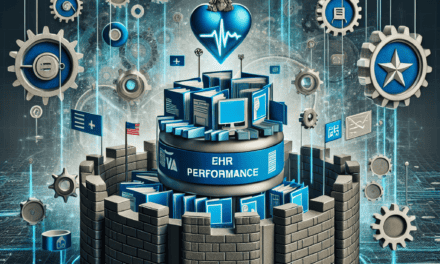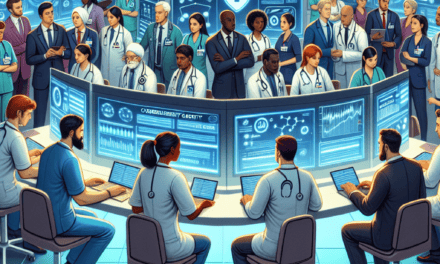Establishing a Robust Infrastructure for Medical Data Exchange

In the rapidly evolving landscape of healthcare, the exchange of medical data is becoming increasingly critical. As healthcare providers strive to deliver more personalized and efficient care, the need for a robust infrastructure to support the seamless exchange of medical data is paramount. This article explores the essential components and considerations for establishing a robust infrastructure for medical data exchange, delving into the technological, regulatory, and organizational aspects that must be addressed.
1. The Importance of Medical Data Exchange
The exchange of medical data is a cornerstone of modern healthcare. It enables healthcare providers to access comprehensive patient information, leading to improved diagnosis, treatment, and patient outcomes. However, the importance of medical data exchange extends beyond individual patient care. It also plays a crucial role in public health, research, and healthcare system efficiency.
1.1 Enhancing Patient Care
Medical data exchange allows healthcare providers to access a patient’s complete medical history, including previous diagnoses, treatments, and medications. This comprehensive view enables more accurate diagnoses and personalized treatment plans. For example, a study published in the Journal of the American Medical Informatics Association found that access to comprehensive electronic health records (EHRs) reduced the rate of diagnostic errors by 30%.
Moreover, medical data exchange facilitates continuity of care, especially for patients with chronic conditions who see multiple specialists. By sharing data across providers, healthcare teams can coordinate care more effectively, reducing the risk of redundant tests and conflicting treatments.
1.2 Supporting Public Health Initiatives
Beyond individual patient care, medical data exchange is vital for public health initiatives. By aggregating and analyzing data from various sources, public health officials can identify trends, track disease outbreaks, and allocate resources more effectively. For instance, during the COVID-19 pandemic, data exchange between healthcare providers and public health agencies was crucial for tracking the spread of the virus and implementing timely interventions.
1.3 Facilitating Medical Research
Medical data exchange also plays a pivotal role in research. By providing researchers with access to large datasets, it enables the identification of patterns and correlations that can lead to new medical discoveries. For example, the All of Us Research Program, a National Institutes of Health initiative, relies on data exchange to gather health information from diverse populations, aiming to accelerate research and improve health outcomes.
1.4 Improving Healthcare System Efficiency
Efficient medical data exchange can significantly reduce administrative burdens and costs associated with manual data entry and paper-based records. According to a report by the Office of the National Coordinator for Health Information Technology, hospitals that adopted EHRs and engaged in data exchange saw a 15% reduction in administrative costs. This efficiency allows healthcare providers to allocate more resources to patient care.
1.5 Addressing Challenges in Data Exchange
Despite its benefits, medical data exchange faces several challenges, including data privacy concerns, interoperability issues, and the need for standardized data formats. Addressing these challenges is essential to realizing the full potential of medical data exchange and ensuring that it benefits all stakeholders in the healthcare ecosystem.
2. Technological Foundations for Medical Data Exchange
Establishing a robust infrastructure for medical data exchange requires a solid technological foundation. This includes the adoption of interoperable systems, secure data transmission protocols, and advanced data analytics capabilities. In this section, we explore the key technological components necessary for effective medical data exchange.
2.1 Interoperability Standards
Interoperability is the ability of different systems and organizations to work together seamlessly. In the context of medical data exchange, interoperability ensures that data can be shared and understood across different healthcare systems. The Health Level Seven International (HL7) standards, including the Fast Healthcare Interoperability Resources (FHIR) framework, are widely adopted to facilitate interoperability in healthcare.
FHIR, in particular, provides a standardized way to represent and exchange healthcare information electronically. It enables developers to create applications that can access and use data from different EHR systems, promoting innovation and improving patient care.
2.2 Secure Data Transmission
Security is a critical concern in medical data exchange. Healthcare data is highly sensitive, and unauthorized access can have severe consequences for patients and providers. To ensure secure data transmission, healthcare organizations must implement robust encryption protocols and access controls.
Transport Layer Security (TLS) is commonly used to encrypt data in transit, protecting it from interception and tampering. Additionally, organizations should adopt multi-factor authentication and role-based access controls to ensure that only authorized personnel can access sensitive data.
2.3 Cloud-Based Solutions
Cloud-based solutions offer several advantages for medical data exchange, including scalability, cost-effectiveness, and accessibility. By storing data in the cloud, healthcare providers can easily share information with authorized users, regardless of their location.
Moreover, cloud-based solutions often come with built-in security features, such as data encryption and automatic backups, reducing the burden on healthcare organizations to manage these aspects themselves. However, it is essential to choose reputable cloud service providers that comply with healthcare regulations, such as the Health Insurance Portability and Accountability Act (HIPAA) in the United States.
2.4 Advanced Data Analytics
Advanced data analytics capabilities are essential for extracting valuable insights from medical data. By analyzing large datasets, healthcare providers can identify trends, predict patient outcomes, and make data-driven decisions.
Machine learning and artificial intelligence (AI) are increasingly being used to enhance data analytics in healthcare. For example, AI algorithms can analyze medical images to detect abnormalities, assist in diagnosing diseases, and recommend treatment options. These technologies have the potential to revolutionize patient care and improve healthcare outcomes.
2.5 Integration with Existing Systems
Integrating new data exchange solutions with existing healthcare systems is a critical consideration. Many healthcare organizations have invested heavily in legacy systems, and replacing them entirely may not be feasible. Therefore, new solutions must be compatible with existing systems to ensure a smooth transition and minimize disruptions to patient care.
Application programming interfaces (APIs) play a crucial role in facilitating integration. By providing a standardized way for different systems to communicate, APIs enable seamless data exchange and interoperability between new and existing systems.
3. Regulatory and Compliance Considerations
Regulatory and compliance considerations are paramount when establishing a robust infrastructure for medical data exchange. Healthcare organizations must navigate a complex landscape of regulations and standards to ensure that data exchange is conducted legally and ethically. This section explores the key regulatory and compliance considerations that must be addressed.
3.1 Data Privacy Regulations
Data privacy is a significant concern in medical data exchange. Healthcare organizations must comply with data privacy regulations to protect patient information and avoid legal repercussions. In the United States, HIPAA sets the standard for protecting sensitive patient information, while the General Data Protection Regulation (GDPR) governs data privacy in the European Union.
These regulations require healthcare organizations to implement measures to safeguard patient data, such as encryption, access controls, and data anonymization. Additionally, organizations must obtain patient consent before sharing their data and provide mechanisms for patients to access and control their information.
3.2 Data Sharing Agreements
Data sharing agreements are essential for establishing clear terms and conditions for data exchange between organizations. These agreements outline the responsibilities of each party, including data security measures, data usage restrictions, and liability in case of data breaches.
Healthcare organizations should work closely with legal experts to draft comprehensive data sharing agreements that comply with relevant regulations and protect the interests of all parties involved. These agreements should be regularly reviewed and updated to reflect changes in regulations and organizational needs.
3.3 Standardization and Certification
Standardization and certification are critical for ensuring that medical data exchange solutions meet industry standards and best practices. Organizations should seek certification from recognized bodies, such as the Office of the National Coordinator for Health Information Technology (ONC) in the United States, to demonstrate compliance with interoperability and security standards.
Certification provides assurance to healthcare providers and patients that data exchange solutions are reliable and secure. It also facilitates trust and collaboration between organizations, promoting the widespread adoption of data exchange technologies.
3.4 Ethical Considerations
Ethical considerations are an integral part of medical data exchange. Healthcare organizations must ensure that data exchange practices respect patient autonomy, privacy, and confidentiality. This includes obtaining informed consent from patients before sharing their data and providing transparency about how their information will be used.
Additionally, organizations should consider the potential impact of data exchange on vulnerable populations and take steps to mitigate any negative consequences. This may involve implementing measures to prevent discrimination or bias in data analysis and decision-making processes.
3.5 International Data Exchange
International data exchange presents unique regulatory and compliance challenges. Healthcare organizations must navigate different legal frameworks and data protection laws when exchanging data across borders. This requires a thorough understanding of international regulations and collaboration with legal experts to ensure compliance.
Organizations should also consider the potential benefits of international data exchange, such as access to diverse datasets and collaboration with global research initiatives. By addressing regulatory and compliance challenges, healthcare organizations can leverage international data exchange to advance medical research and improve patient care worldwide.
4. Organizational Strategies for Successful Data Exchange
Establishing a robust infrastructure for medical data exchange requires more than just technological solutions. It also involves strategic organizational planning and collaboration. This section explores the key organizational strategies that healthcare providers can adopt to facilitate successful data exchange.
4.1 Building Collaborative Networks
Collaboration is essential for successful medical data exchange. Healthcare organizations should build networks with other providers, research institutions, and public health agencies to facilitate data sharing and collaboration. These networks can help identify common goals, share best practices, and address challenges collectively.
For example, the Health Information Exchange (HIE) networks in the United States enable healthcare providers to share patient information securely and efficiently. By participating in HIEs, organizations can access a broader range of data and improve patient care coordination.
4.2 Investing in Workforce Training
A skilled workforce is crucial for implementing and managing medical data exchange solutions. Healthcare organizations should invest in training programs to equip their staff with the necessary skills and knowledge to use data exchange technologies effectively.
Training programs should cover topics such as data privacy regulations, interoperability standards, and data analytics. By empowering their workforce with the right skills, organizations can maximize the benefits of data exchange and improve patient care outcomes.
4.3 Establishing Governance Frameworks
Governance frameworks are essential for ensuring that medical data exchange is conducted in a structured and accountable manner. These frameworks should outline the roles and responsibilities of different stakeholders, establish data sharing policies, and define processes for monitoring and evaluating data exchange activities.
Healthcare organizations should establish governance committees or working groups to oversee data exchange initiatives and ensure compliance with regulations and standards. These committees can also facilitate communication and collaboration between different departments and organizations.
4.4 Fostering a Culture of Data-Driven Decision Making
To fully leverage the benefits of medical data exchange, healthcare organizations should foster a culture of data-driven decision making. This involves encouraging staff to use data insights to inform clinical and operational decisions and promoting a mindset of continuous improvement.
Organizations can achieve this by providing access to data analytics tools and resources, recognizing and rewarding data-driven initiatives, and promoting a culture of transparency and accountability. By embedding data-driven decision making into their organizational culture, healthcare providers can improve patient care and operational efficiency.
4.5 Engaging Patients in Data Exchange
Engaging patients in the data exchange process is essential for building trust and ensuring that data exchange initiatives align with patient needs and preferences. Healthcare organizations should involve patients in discussions about data sharing practices and provide them with tools to access and control their information.
Patient portals and mobile applications can empower patients to view their medical records, track their health data, and communicate with their healthcare providers. By involving patients in the data exchange process, organizations can enhance patient engagement and improve health outcomes.
5. Case Studies and Real-World Examples
To illustrate the practical application of medical data exchange infrastructure, this section presents case studies and real-world examples of successful data exchange initiatives. These examples highlight the benefits and challenges of implementing data exchange solutions in different healthcare settings.
5.1 The Indiana Health Information Exchange (IHIE)
The Indiana Health Information Exchange (IHIE) is one of the largest and most successful health information exchanges in the United States. It connects over 100 hospitals and 18,000 healthcare providers, facilitating the exchange of patient information across the state.
IHIE’s success is attributed to its robust technological infrastructure, strong governance framework, and collaborative partnerships with healthcare providers and public health agencies. By providing real-time access to patient information, IHIE has improved care coordination, reduced duplicate tests, and enhanced patient outcomes.
5.2 The UK’s National Health Service (NHS) Digital
The UK’s National Health Service (NHS) Digital is a leading example of a national-level data exchange initiative. NHS Digital provides a centralized platform for sharing patient information across different healthcare settings, including hospitals, primary care, and social care.
NHS Digital’s success is driven by its commitment to interoperability standards, data privacy regulations, and patient engagement. By enabling seamless data exchange, NHS Digital has improved care continuity, reduced administrative burdens, and supported public health initiatives.
5.3 The All of Us Research Program
The All of Us Research Program is a groundbreaking initiative by the National Institutes of Health (NIH) that aims to gather health data from one million diverse participants in the United States. The program relies on robust data exchange infrastructure to collect, store, and analyze health information from participants.
By leveraging advanced data analytics and cloud-based solutions, the All of Us Research Program is accelerating medical research and enabling personalized medicine. The program’s success demonstrates the potential of data exchange to drive innovation and improve health outcomes.
5.4 The Singapore National Electronic Health Record (NEHR)
The Singapore National Electronic Health Record (NEHR) is a comprehensive data exchange platform that connects healthcare providers across the country. The NEHR provides a single source of truth for patient information, enabling seamless data exchange and care coordination.
The NEHR’s success is attributed to its strong regulatory framework, commitment to interoperability standards, and focus on patient engagement. By providing healthcare providers with access to complete patient information, the NEHR has improved care quality and patient safety.
5.5 The Australian My Health Record System
The Australian My Health Record system is a national digital health record platform that allows patients to access and control their health information. The system enables data exchange between healthcare providers, improving care coordination and patient outcomes.
The My Health Record system’s success is driven by its focus on patient empowerment, data privacy, and interoperability. By providing patients with control over their health information, the system has enhanced patient engagement and supported personalized care.
Conclusion
Establishing a robust infrastructure for medical data exchange is essential for improving patient care, supporting public health initiatives, and advancing medical research. By addressing technological, regulatory, and organizational considerations, healthcare providers can create a seamless and secure data exchange environment that benefits all stakeholders.
The examples and case studies presented in this article demonstrate the potential of medical data exchange to transform healthcare delivery and improve health outcomes. By adopting best practices and leveraging innovative technologies, healthcare organizations can overcome challenges and realize the full potential of medical data exchange.
As the healthcare landscape continues to evolve, the importance of medical data exchange will only grow. By investing in robust infrastructure and fostering collaboration, healthcare providers can ensure that they are well-positioned to meet the demands of the future and deliver high-quality care to their patients.





